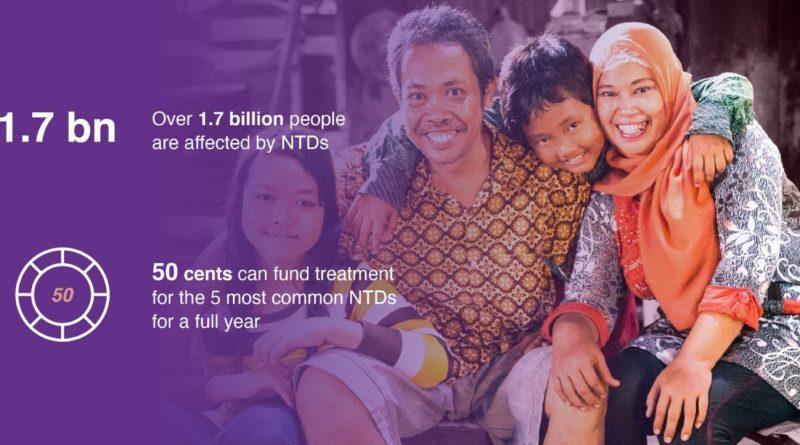World NTD Day January 30, 2022: Achieving health equity to end the neglect of poverty-related diseases
Join us on 30 January, for the third annual #WorldNTDDay2022.
World NTD Day serves as a catalyst to translate awareness into action, secure increased resources for neglected tropical diseases (NTDs), and crucially facilitate political leadership and ownership of NTD programmes from affected countries.
Neglected tropical diseases (NTDs) are widespread in the world’s poorest regions, where water safety, sanitation and access to health care are substandard. NTDs affect over 1 billion people globally and are caused mostly by a variety of pathogens including viruses, bacteria, parasites, fungi, and toxins.
These diseases are “neglected” because they are almost absent from the global health agenda, enjoy little funding, and are associated with stigma and social exclusion. They are diseases of neglected populations that perpetuate a cycle of poor educational outcomes and limited professional opportunities
World Neglected Tropical Diseases Day (WNTDD) will be celebrated on Sunday 30 January 2022. To mark this celebration, WHO is organizing a virtual event, calling on everyone to address the inequalities that characterize NTDs. WNTDD is an opportunity to re-energize the momentum to end the suffering from these 20 diseases that are caused by a variety of pathogens including viruses, bacteria, parasites, fungi and toxins.
The day provides an opportunity to focus on the millions of people who have limited or no access to prevention, treatment and care services.
Join us to celebrate the event on 26 January 2022 14:00–15:00 (CET).
Registration link
(https://who.zoom.us/webinar/register/WN_vvzLo48nQlCzItEeVndeuA)
List of the Neglected Tropical Diseases (NTDs)
Buruli ulcer
A debilitating mycobacterial skin infection causing severe destruction of the skin, bone and soft tissue.
Chagas Disease
A life-threatening protozoan illness transmitted to humans through contact with vector insects (triatomine bugs), ingestion of contaminated food, infected blood transfusions, congenital transmission, organ transplantation or laboratory accidents
Dengue and chikungunya
Two mosquito-borne, outbreak-prone viral conditions causing a flu-like illness that can be associated with severe, painful and disabling symptoms and, in the case of dengue, may cause shock, haemorrhage and death.
Dracunculiasis (guinea-worm disease)
A helminth infection transmitted exclusively by drinking water contaminated with parasite-infected water fleas; one year later, adult female worms painfully ulcerate through the skin, often of the legs, in order to expel their larvae.
Echinococcosis
A disease caused by the larval stages of tapeworms forming pathogenic cysts in human organs, acquired by ingesting eggs most commonly shed in the faeces of dogs and wild animals.
Foodborne trematodiases
A group of infectious diseases acquired by consuming fish, crustaceans and vegetables contaminated with larval parasites; clonorchiasis, opisthorchiasis, paragonimiasis and fascioliasis are the most common.
Human African trypanosomiasis (sleeping sickness)
A protozoan infection spread by the bites of tsetse flies that is almost 100% fatal without prompt diagnosis and treatment to prevent the parasites from invading the central nervous system.
Leishmaniases
A group of protozoan diseases transmitted through the bites of infected female sandflies; the most severe (visceral) form attacks the internal organs and in its most prevalent (cutaneous) form causes skin ulcers, disfiguring scars and disability.
Leprosy
A complex disease caused by infection with a slow-growing bacterium, mainly affecting the skin, peripheral nerves and eyes.
Lymphatic filariasis (elephantiasis)
A helminth infection transmitted by mosquitoes and resulting in adult worms inhabiting and reproducing in the lymphatic system; it is associated with recurrent painful inflammation and abnormal enlargement of limbs and genitals.
Mycetoma, chromoblastomycosis and other deep mycoses
Chronic, progressively destructive inflammatory diseases of the skin and subcutaneous tissues which usually affect the lower limbs. People become infected when injuries break the skin and allow fungi (and bacteria in the case of mycetoma) to enter the body.
Onchocerciasis (river blindness)
A helminth infection transmitted by the bite of infected blackflies causing severe itching and eye lesions as the adult worm produces larvae eventually leading to visual impairment and permanent blindness.
Rabies
A preventable viral disease transmitted to humans through the bites of infected animals, especially dogs, that is invariably fatal once symptoms develop.
Scabies and other ectoparasitoses
A group of infestations of the skin caused by mites, fleas or lice; scabies occurs when the human itch mite burrows into the upper layer of the skin where it lives and lays its eggs, causing intense itching and rash.
Schistosomiasis (bilharzia)
A group of trematode infections acquired when larval forms released by freshwater snails penetrate human skin during contact with infested water; schistosomiasis is typically associated with liver and urogenital pathology.
Snakebite envenoming
A potentially life-threatening condition caused by toxins injected through the bite of a venomous snake, often responsible for acute medical emergencies. Envenoming can also be caused by having venom sprayed into the eyes by certain species of snakes
Soil-transmitted helminthiases
Helminth infections transmitted through soil contaminated by human faeces; they cause anaemia, vitamin A deficiency, stunted growth, malnutrition, intestinal obstruction and impaired development.
Taeniasis and cysticercosis
Taeniasis is caused by adult tapeworms in human intestines; cysticercosis results when humans ingest tapeworm eggs that develop as larvae in tissues, including the brain (neurocysticercosis).
Trachoma
A bacterial infection transmitted through direct contact with infectious eye or nasal discharge, and associated with unsafe living conditions and hygiene practices; if left untreated, it causes irreversible corneal opacities and blindness.
Yaws
A chronic, disfiguring bacterial disease affecting mainly the skin and bone. Other endemic treponematoses similar to yaws are also considered NTDs
Join us to celebrate the World Neglected Tropical Disease (NTD) Day on 26 January 2022 14:00–15:00 (CET).
Registration link
(https://who.zoom.us/webinar/register/WN_vvzLo48nQlCzItEeVndeuA)




